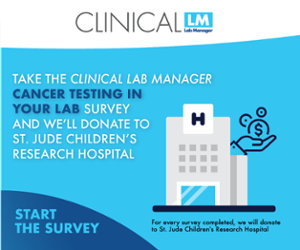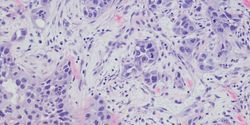Multiplexed Immunohistochemistry: Maximizing the Use of Tissue Sections
A technique at the intersection of high throughput and high resolution
Immunohistochemistry (IHC) has long been used in research and diagnostic laboratories to measure protein expression and localization within tissues. It is an important tool for characterizing heterogenous cell types, such as those found in tumors or brain sections. However, traditional IHC cannot reliably detect more than three protein targets at once.
Multiplexed immunohistochemistry (mIHC) can be used to detect anywhere from three to more than 30 protein targets within a tissue section1. Thus, the technique allows information on a large number of proteins to be collected from a small tissue sample. technology
Types of multiplexed IHC
Similar to traditional IHC, mIHC is based on the interaction between an antibody and its target antigen. Primary or secondary antibodies conjugated to a chromogen or fluorescent dye are used for detection.
Chromogenic mIHC
Chromogens are soluble substrates that form colored precipitates in the presence of enzymes. For high abundance molecular targets, chromogenic mIHC may employ primary antibodies that are directly conjugated with different chromogens. Alternatively, the primary antibodies may interact with chromogen-conjugated secondary antibodies to enable signal amplification for low abundance targets. Multiple staining cycles are performed if multiple proteins are to be visualized in a single tissue section.
Fluorescent mIHC
Fluorescent dyes such as FITC, TRITC, Cy3, and Cy5 are used to visualize protein targets. Conventionally, each fluorophore is imaged separately and the individual images are then merged together to evaluate localization of multiple proteins. Alternatively, multispectral analysis can be performed, wherein representative emission spectra of individual fluorophores are saved. The intensity of fluorescent targets is then compared against this multispectral library during quantification. To avoid multiple rounds of antibody staining, imaging, and fluorophore bleaching or antibody removal, mass spectrometry-based approaches have been optimized. These employ rare earth metalconjugated antibodies for immunostaining, followed by high-frequency laser ablation and mass spectrometry for increased subcellular resolution2.
Tyramide signal amplification (TSA)
TSA is an enzyme-mediated detection method that uses the catalytic activity of peroxidase enzyme to enhance fluorescence labeling of target proteins. The enzyme catalyzes the binding of tyramide-labeled fluorophores to tyrosine residues on the target protein. With fluorophores deposited on several tyrosine residues around the antibody complex, an amplified signal is produced. This technique allows the use of multiple antibodies raised in the same host species without risk of cross reactivity. Although TSA can be applied to both chromogenic and fluorescent mIHC, the latter is preferred because the fluorescent spectrum allows more dyes to be introduced.
Applications of multiplexed IHC
mIHC is an effective way to extract maximum data from tissues with limited availability. This makes it an ideal tool for studying cellular heterogeneity in oncology and neurology.
Oncology
Failure of cancer treatments is widely attributed to tumor heterogeneity. mIHC on biopsied tissues can aid the rapid classification of tumor subtypes, without using up too much sample. For instance, breast cancer is classified based on the presence or absence of estrogen, progesterone, and Her2 receptors. In one study on breast cancer samples, 32-plex mIHC combined with mass cytometry showed inter-patient variability as well as differences in protein expression within the same tumor2. Such classification can facilitate tailored therapy and disease prognosis.
Immune cells in the tumor microenvironment also affect response to immunotherapy. Using mIHC, researchers labeled head and neck cancer biopsy samples with 12 antibody panels to measure lymphoid and myeloid phenotype in leukocytes3. Myeloid-enriched tumors in the study were associated with lower survival and had poor therapeutic response to the GVAX cancer vaccine. Therefore, mIHC may be used to gain insights into the tumor microenvironment and quantify predictive biomarkers to stratify patients based on their therapeutic response.
Neurology
We are yet to fully unravel the mysteries of the brain. A deeper understanding of neuroanatomy is the first step towards this goal. mIHC can be used to label brain cells, neurotransmitters, the blood-brain barrier, and peripheral players such as immune cells. For instance, mIHC with TSA has been used to detect trace amounts of the neurotransmitter dopamine and choline acetyltransferase in postmortem human brains4.
mIHC can also be used to identify and monitor biomarkers of neurodegenerative disease progression. One study used mIHC to assess neuroinflammation and neural tissue damage in a rat model of traumatic brain injury5. Ten antibodies were used to evaluate changes in the location and functional states of immune cells and characterize neural repair and regeneration over time. Recently, an mIHC protocol was developed to detect signs of Alzheimer’s disease in human postmortem brain tissue6. An Alzheimer’s disease biomarker was co-stained with neuronal and astrocyte markers to develop a protocol that can also be implemented by other laboratories studying neurodegenerative diseases. Fluorescent mIHC combined with mass spectrometry was used to characterize glial phenotypes in multiple sclerosis lesions at various stages of the disease7.
Advantages of multiplexed IHC
Similar to other molecular biology techniques like gene expression profiling and flow cytometry, mIHC provides information on multiple cellular targets in sparse samples. However, mIHC offers the added advantage of preserving tissue architecture, providing a spatial overview of protein co-localization and interactions, often at subcellular resolution.
Chromogenic mIHC enables detection of low abundance proteins with high sensitivity. The colored precipitates formed produce more durable staining, allowing long-term storage without signal degradation. Fluorescent mIHC combined with tyramide signal amplification, enables detection of a large array of proteins, even those with low levels of expression. It is also an ideal tool for measuring protein co-localization.
Limitations of multiplexed IHC
Chromogenic mIHC has limited multiplexing capacity due to spectral overlap and cross-reactivity between available antibodies. Also, it is not ideal for studying protein co-localizations. Fluorescent mIHC requires specialized equipment such as microscopes fitted with appropriate wavelength filters. The fluorophores may also undergo photobleaching over time, limiting long-term storage of fluorescently-labeled tissue sections.
Compared to other techniques, mIHC may require multiple cycles that make the protocols complex, difficult to optimize, and affect antibody binding. Furthermore, image analysis may be subjective, time-consuming, or require expert input. However, these limitations can be overcome by digital image analysis and artificial intelligence- assisted technologies.
Conclusion
Multiplexed IHC is a powerful tool for investigating the biology of complex disease, especially when there is a paucity of clinical samples. A workflow that seamlessly integrates automated staining, whole-slide imaging, and validated image analysis is crucial for developing clinically relevant in vitro diagnostics.
References
1. Stack, Edward C., et al. “Multiplexed immunohistochemistry, imaging, and quantitation: a review, with an assessment of tyramide signal amplification, multispectral imaging and multiplex analysis.” Methods (2014): 46-58.
2. Giesen, Charlotte, et al. “Highly multiplexed imaging of tumor tissues with subcellular resolution by mass cytometry.” Nature Methods (2014): 417-22.
3. Tsujikawa, Takahiro, et al. “Quantitative multiplex immunohistochemistry reveals myeloid-inflamed tumor-immune complexity associated with poor prognosis.” Cell Reports (2017): 203-217.
4. Goto, Satoshi, et al. “Development of a highly sensitive immunohistochemical method to detect neurochemical molecules in formalin-fixed and paraffin-embedded tissues from autopsied human brains.” Frontiers in Neuroanatomy (2015):22.
5. Bogoslovsky, Tanya, et al. “Development of a systems-based in situ multiplex biomarker screening approach for the assessment of immunopathology and neural tissue plasticity in male rats after traumatic brain injury.” Journal of Neuroscience Research (2018): 487-500.
6. Ehrenberg, Alexander J., et al. “A manual multiplex immunofluorescence method for investigating neurodegenerative diseases.” bioRxiv doi: https://doi.org/10.1101/533547
7. Park, Calvin, et al. “The landscape of myeloid and astrocyte phenotypes in acute multiple sclerosis lesions.” Acta Neuropathologica Communications (2019): 130.



